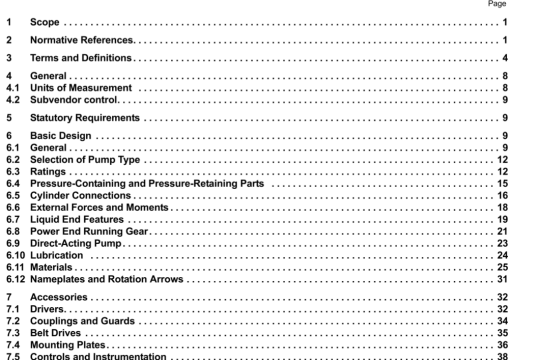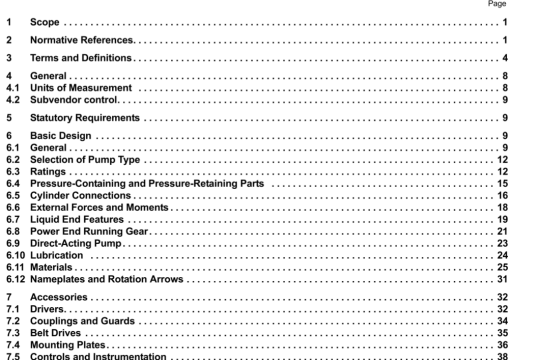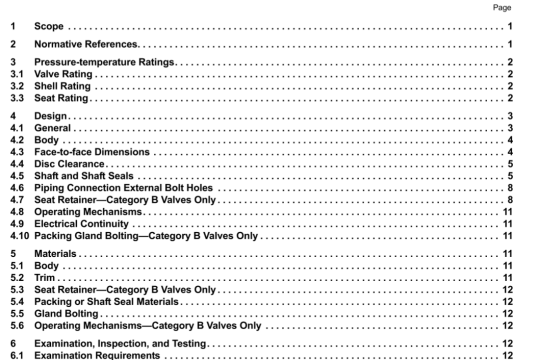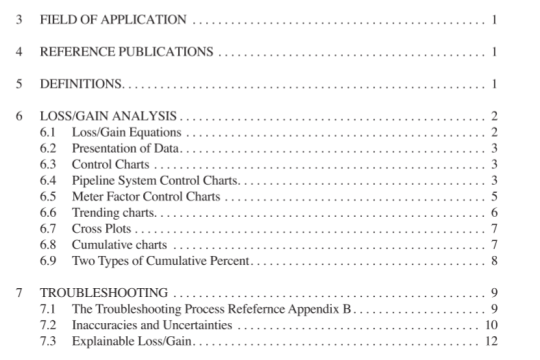API STD 600:2001 pdf download
API STD 600:2001 pdf download.Bolted Bonnet Steel Gate Valves for Petroleum and Natural Gas lndustries.
5.3.4 Openings
Tapped openings are prohibited unless specified by the purchaser. All openings shall be in accordance with 5.12. When tapped openings are permitted for testing, they shall not be larger than ON 15.
5.4 Bonnet dimensions
5.4.1 The bonnet stem hole shall be designed to have proper clearance for stem guiding and for the prevention 01 packing extrusion.
5.4.2 The bonnet shall include a conical stem backseat in one of the following forms:
—a bushing:
— an integral surface in the case of an austenitic stainless steel valve;
— an austenilic stainless steel o hardlace weld deposit with a minimum thickness of 1,6 mm.
5.4.3 The restrictions of 5.3.4 on openings also apply to the bonnet.
5.4.4 Bonnets shall be one piece castings or forgings subject to the same requirements and exceptions as specified in 5.3,1.3.
5.4.5 The gland bolting shall not be anchored to the bonnet or yoke through a fillet welded attachment or stud welded pans. The anchor design shall not include slotted holes or brackets which do not shackle gland bolting during repacking.
5.5 Bonnet-to-body ‘oint
5.5.1 The bonnet.to.body joint shall be a flange and gasket type.
5.5.2 For PN 20 valves, the bonnet-to-body joint shall be one of the following types which are illustrated in figure 5 of ISO 7005-1:1992!
—Type A. flat lace;
— Type B, raised face;
— Types C and 0, tongue and groove;
— Types E and F, spigot and recess:
— Type J, ring joint.
5.5.3 For valves having nominal pressure greater than PN 20 the bonnet-to-body joint shall be in accordance with
5.5.2. except that the Type A. flat face, joint is not permitted.
5.5.4 The bonnet flange gasket shall be suitable for the temperature range — 29°C to 538°C and shall be one of the following:
— solid metal, corrugated or flat:
— filled metal jacketed, corrugated or flat:
— metal ring joint:
55.9 At assembly, all gasket contact surfaces shall be free of heavy oils, grease and sealing compounds. A light
coating 01 a lubncant, no heavier than kerosene. may be applied if needed to assist in proper gasket assembly.
5.6 Gate
5.6.1 Gate configurations are categorized as illustrated In Annex B.
5.6.1.1 A one-piece wedge gate, as eithe a solid or flexible wedge design, shall be furnished unless otherwise specified.
5.6.1.2 A two-piece split wedge gate or parallel seat double disc gate may be furnished when specified, A split wedge gate consists of two independent seating parts that conform to the body seats when closed. A double disc gate has a spreading rnechanisrri that forces the two parallel discs to the body seats when dosed.
5.6.2 Except for a double dec gate. in the open posaion, the gate shall completely clear the valve seat openings.
5.6.3 Gates shall be designed so that all parts can function properly independent of the installed valve orientation.
5.6.4 Guides shall be provided in the gate and the shell and shall be designed so as to minimze seat wear and maintain gate to stern alignment in all valve orientations. Gate-to-shell design shall consider wear that may be caused by corrosion, erosion and abrasion.
5.6.5 Gate seating surfaces shall be integral or faced with weld metal, Unless specified, hard faced seating surfaces are not required. Finished thickness of any facing material shall be not less than 1,6 mm.
5.6.6 Wedge gates shall be designed to account for seat wear. The dimensions that I ix the position of the gate seats relative to the body seats shall be such that the gate. starting from the time of manufacture, can move into the seats, as a restit of seat wear, a distance defined as wear travel, The required minimum wear travel varies with valve size, as given m table 5.
Table 5— MinImum wear travel
Valve size range Minimum wear travel
5.7 Yoke
5.7.1 The yoke may be elther an integral part of the bonnet or a separate part. ibe yoke shall retain the stem nut which links the handwheel to the stem.
5.7.2 kes shall be designed so as to allow the stem nut to be removed when the valve is under pressure without removing the bonnet from the valve body.




